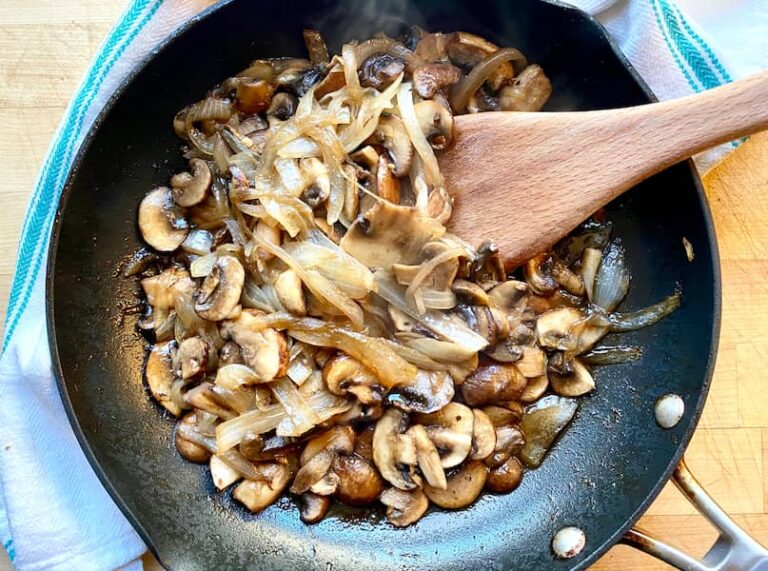Want to try something different from the usual lasagna this Sunday? Let me introduce you to its Greek cousin!
Pastitsio is an ancient dish from the Balkan tradition that is widespread both on the Hellenic peninsula and in other Mediterranean regions such as Egypt and Malta. It’s made by baking tubular pasta like penne or bucatini with meat sauce, bechamel sauce, and other ingredients such as feta cheese, eggs, and spices.
Its name comes from the Latin pasticium, which indicates a pasta preparation, and it is very similar to our timballo, or a more elaborate version of baked ziti.
It’s internationally known as the Greek version of lasagna, but I think its taste is too unique to be mindlessly thrown into the vast world of lasagna recipes. Therefore, although sometimes I’ll call it “Greek Lasagna” for SEO purposes throughout this post, I will also use its original name.
Whatever you decide to call it, follow me as I show you how to make this masterpiece at home!
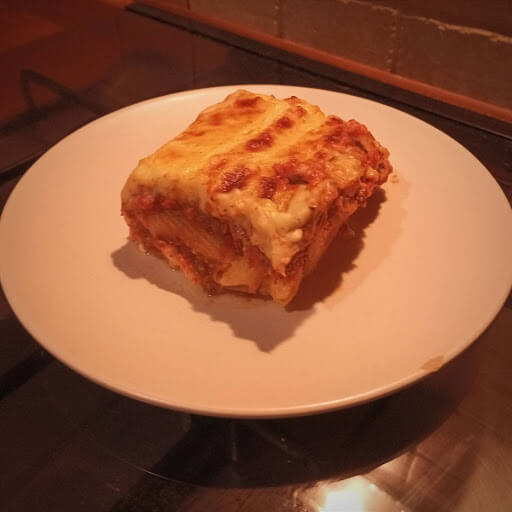
What You’ll Need
Dry pasta: unlike Italian lasagna, Pastitsio doesn’t have different layers of pasta. It’s made of just one thick bottom layer of tubular pasta shapes. I’ve opted for a mix of rigatoni and penne pasta, but you can also use bucatini pasta, mezze maniche, and many more.
Eggs: you will need to use the egg yolks and whites separately, so make sure to divide them before you start.
Bechamel sauce: as per usual, I recommend making your own with. For some reason, it’s very difficult to find a good bechamel in stores. I wrote a simple recipe for this blog made with flour, butter, whole milk, ground nutmeg, and pepper – but this time, I also recommend adding some egg yolks and a bit of grated kefalotyri cheese.
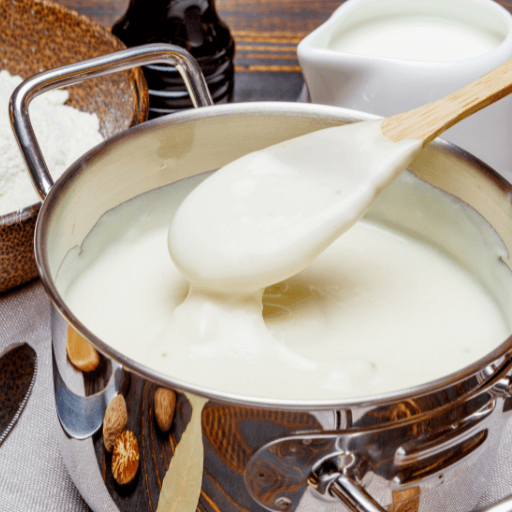
Aside from these, you will also need the following ingredients for the meat sauce.
Olive oil: to grease the saucepan and immediately give the sauce a Mediterranean flavor.
Finely chopped onions: unlike my usual meat sauces, this one is made only with onions instead of the usual soffritto.
Ground beef: the meat base of our sauce.
Red wine: to deglaze.
Tomato puree: or a tablespoon of tomato paste, if you prefer.
Salt, ground pepper, cinnamon, oregano, and ground cloves: the spices of choice for this sauce.
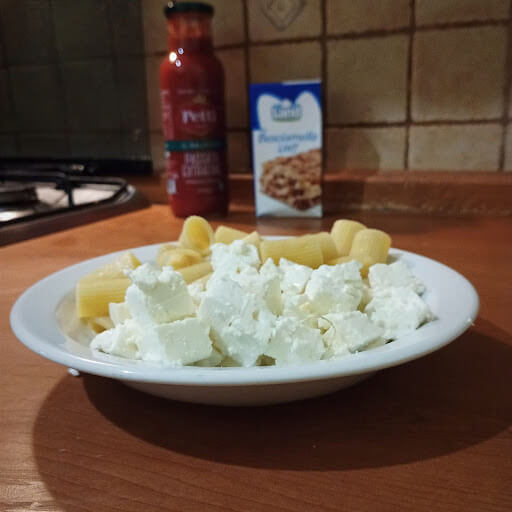
Method
Step 1 – Prepare the bechamel sauce and set it aside
Let’s start by preparing the bechamel sauce. You could do it later while the meat sauce simmers, but I find it’s best to be 100% focused during the process.
Take two small pots, and use them separately to heat the milk and melt the butter on low heat.
Once the butter melts, turn off the heat and add the flour, mixing constantly with a kitchen whisk to avoid lumps from forming. After that, turn the fire back on and heat the sauce over a low flame until it becomes golden.
This is what the French call “roux“.
Now, add the milk (always stirring constantly) and let the sauce thicken for no more than 5 minutes. Then, remove the pan from the stove and add the egg yolks, salt, pepper, nutmeg, and grated cheese. Whisk the bechamel quickly to prevent the egg yolks from coagulating and turning into an omelet.
Finally, take the pot away from the stove and set aside.

Step 2 – Prepare the meat sauce
Add the meat to a large saucepan with a drizzle of olive oil and cook on medium heat until it starts to brown. In the meantime, break it up with a wooden spoon, then add all the spices, and mix.
When the meat becomes brown, add the finely chopped onions and deglaze with the red wine. Then, let it all simmer until the wine evaporates.
After that, add the tomato sauce, lower the heat to the minimum, cover with a lid, and let the sauce simmer for at least 30 minutes while you take care of the rest.
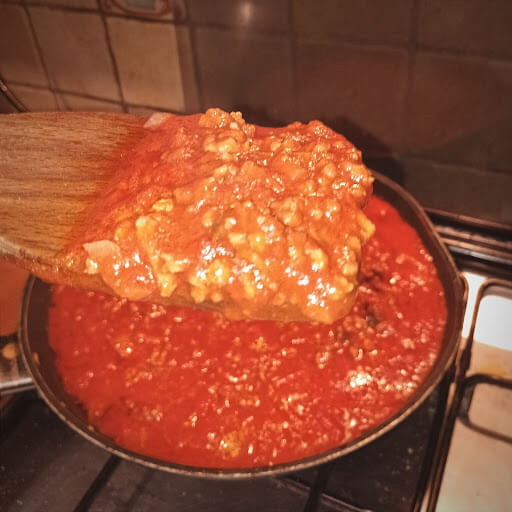
Step 3 – Cook the pasta
While the meat sauce simmers, take a large pot, fill it with water, and bring it to a boil. Add a tablespoon of coarse salt and wait until the water gets to a rolling boil, then add the pasta and let it cook at medium-high heat for 3 minutes less than the time reported on the cooking instructions.
While the pasta cooks, take a baking dish and grease its surface with a little butter.
When the pasta is ready, drain it and add it to the baking dish. Mix it with the diced feta cheese and the egg whites, then set aside.
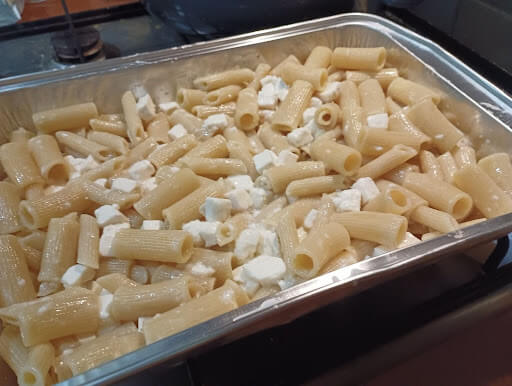
Phase 4 – Assemble your Greek Lasagna & Bake
First, preheat your oven to 350°F (180°C) on fan mode.
At this point, the meat sauce should have reduced enough to have barely any liquid in it. Spread it evenly on top of the pasta layer in the baking dish.
Then, add a layer of bechamel on top of the meat sauce and smooth it with a spatula. You can add some more grated kefalotyri or parmesan cheese, if you want.
Bake your Greek Lasagna in the oven for 40 minutes, then take it out and let it cool for a few minutes before serving.
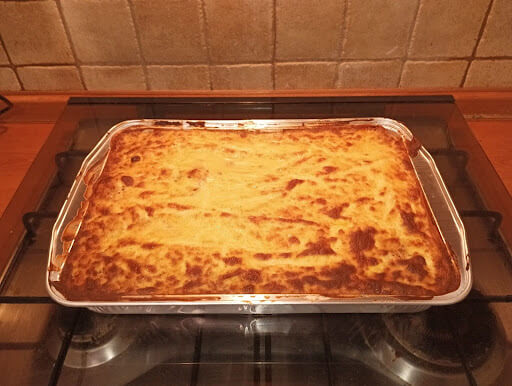
What to Serve With Greek Lasagna
If you’re making this Greek Lasagna for a weeknight dinner, a simple feta salad will do. If, on the other hand, you want to offer a bigger menu to your guests, I suggest having bruschetta as an appetizer, and lamb chops as a second course, plus the salad. We have a delicious Greek Bruschetta recipe, but then feta cheese might become too predominant on the whole menu, so I recommend checking out this bruschetta recipe with mozzarella instead.
Wine pairing: if you can get your hands on a bottle of Xinomavro, go for it! Its black olive tapenade and earthy, fruity notes will balance the rich flavor of the meat filling and bechamel sauce. Otherwise, pick a medium-bodied red wine with low acidity and a vibrant flavor, like a Napa Valley Pinot Noir.
How to Store Greek Lasagna
This pastitsio can be stored in the fridge for 2-3 days.
Alternatively, you can freeze it before baking and store it in the freezer for up to 3 months. Just make sure to freeze it properly, as béchamel can spoil easily if not correctly frozen. When you’re ready to bake it, place it in the oven and cook for 40 minutes at 350°F (180°C) in fan mode.
If you prefer to bake it first and then freeze it, remember to let it thaw in the fridge the night before. Then, reheat it for 20-30 minutes.
Both freezing method are valid. The former will allow you to keep the flavor of the dish intact. However, I don’t know about you, but I also love the taste of leftover pasta stored in the fridge. It’s quite different from freshly cooked pasta, but it’s still really good. I’ve read that this is because when pasta rests after cooking, the starch forms a barrier that changes its flavor and makes it harder to digest, lowering its nutritional value. Is it true? I don’t know, but I’m definitely using it as an excuse to eat leftover pasta free of guilt! 😀
Conclusion & Recipe Card
The first time I tried pastitsio, I was surprised at how good it tasted. Now, it’s my second favorite baked pasta dish, right after vincisgrassi. I really think you’ll fall in love with it as well.
As per usual, here’s the complete recipe card, with precise measures and other important info. Let me know if you try it, and don’t forget to write if you liked it in the comment! Make it nice! 🙂
Print
Pastitsio – Authentic Greek Lasagna Recipe
5 Stars 4 Stars 3 Stars 2 Stars 1 Star
No reviews
- Author: Mortadella Head
- Total Time: 1 hour 40 minutes
- Yield: 8-10 1x
Ingredients
14 oz dry pasta (either bucatini, penne, mezze maniche, or rigationi)
14 oz diced feta cheese
3 egg whites
For the bechamel
1 stick butter (120 g)
1 cup flour (120 g)
4 cups milk (1 l)
3 egg yolks
salt to taste
ground black pepper to taste
nutmeg to taste
grated kefalotyri cheese to taste
For the meat sauce
10 oz ground beef (300 g)
1 finely chopped onion
fine salt to taste
cinnamon to taste
ground cloves to taste
black pepper to taste
oregano to taste
half a glass of red wine to deglaze
2 cups tomato sauce
Instructions
Step 1 – Prepare the bechamel sauce
- Melt butter in a small pot on low heat. Heat milk in a separate pot.
- When the butter melts, turn off the heat. Add flour to the butter and mix with a whisk to make a roux.
- Turn the heat back on and cook the roux until golden.
- Add the warm milk to the roux, stirring constantly, and let the sauce thicken for 5 minutes.
- Remove from heat and quickly whisk in egg yolks, salt, pepper, nutmeg, and grated cheese. Set the bechamel sauce aside.
Step 2 – Prepare the meat sauce
- In a large saucepan, cook meat with olive oil on medium heat until it starts to brown. Break it up with a spoon.
- Add spices and chopped onions to the meat. Cook until onions are soft, then add red wine and let it simmer until the wine evaporates.
- Add tomato sauce to the meat. Lower the heat, cover, and let the sauce simmer for 30 minutes.
Step 3 – Cook the pasta
- Bring a large pot of water to a boil, add salt, and cook pasta for 3 minutes less than the package instructions.
- Grease a baking dish with butter. Drain pasta and mix it with diced feta cheese and egg whites. Put it in the baking dish.
Step 4 – Assemble your Greek Lasagna & Bake
- Preheat the oven to 350°F (180°C) on fan mode.
- Spread the meat sauce layer evenly on top of the pasta.
- Add a layer of bechamel sauce on top of the meat sauce. Smooth it with a spatula.
- Sprinkle with more grated cheese if you like.
- Bake the Greek Lasagna for 40 minutes.
- Let the meat sauce cool for a few minutes before serving.
Notes
Disclaimer: The nutritional information provided for this recipe is only an estimate generated with VeryWellFit’s online calculator. The accuracy of the facts listed is not and cannot be guaranteed. If you need this information for medical reasons please check with your doctor.
- Prep Time: 60 Minutes
- Cook Time: 40 Minutes
- Category: Pasta
- Cuisine: Greek
Nutrition
- Serving Size: 1
- Calories: 765
- Sugar: 13.6g
- Sodium: 2,029mg
- Fat: 34.4g
- Saturated Fat: 19.7g
- Carbohydrates: 73.1g
- Fiber: 4.6g
- Protein: 40.4g
- Cholesterol: 264mg








